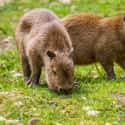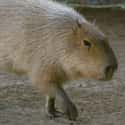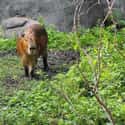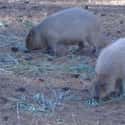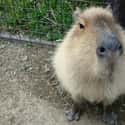-
(#1) Baby Capybaras Can't Swim
Though the majority of their lives will ultimately be spent in the water, newborn capybaras are not very good swimmers. As a result, they spend their first several months living near the water, hidden by large brush.
The entire capybara group works to nurse the young and protect them from harm. Baby capybaras nurse on every female in the community, and beta males work to stay vigilant to protect the group from harm.
-
(#2) Capybaras Get To The Size Of A Small St. Bernard
Unlike most members of the rodent family, capybaras’ heads are flat and square-shaped. The females tend to be a little larger than the males, but in general they reach approximately the same physical size.
Capybaras can reach about four feet long and about 20 inches tall. Within that relatively small frame, capybaras pack a lot of density, weighing up to 175 pounds.
-
(#3) Capybaras Are Most Commonly Active At Dawn And Dusk
When comfortable in their environment, capybaras act as crepuscular animals. This means they’re most often active at dawn and dusk, sleeping through the heat of the day and hiding out at night.
Should they feel as though a threat is present, capybaras can also convert to completely nocturnal behavior in which they eat and socialize entirely at night.
-
(#4) Capybara Can Stay Submerged Underwater For Up To Five Minutes
After living among marshes and swamps, Capybaras have evolved to thrive in aquatic environments. Their skin needs to be kept constantly moist and their daily diet consists primarily of aquatic plants.
Also known as water hogs, wild capybaras sleep along river banks and streams. They’re often found in dense vegetation, a preference that keeps them cool and hides them from predators.
-
(#5) Capybara Are Designed To Thrive In The Water
The capybara may not seem like the most agile animal on the planet, but in the water they possess a striking mobility. Their webbed feet make it possible for them to walk through the mud and swim through rivers and streams with ease.
Furthermore, their facial features are designed to cope with the water. Their eyes and nostrils are located at the top of their heads which allows them to breathe and stay submerged simultaneously, much like crocodiles. When submerged, their ears also close to keep the water out.
-
(#6) Unlike A Lot Of Animals, Capybaras Can Get Sunburns
Typically appearing as reddish brown to gray, the capybara’s muted colors are one of their natural evolutionary developments. Another development, their thin, wiry coat, is designed to dry quickly when they exit the water.
Thus, sunburns become a possibility due to the capybara's thin coat. They counter this possibility by caking their skin in mud, another reason they’re known as water hogs. The capybara’s unique pelt also makes them a valuable hunting commodity, even in modern times.
-
(#7) Capybaras Are Incredibly Picky Eaters
Exclusively herbivores, capybara eat a small variety of aquatic plants and grasses. The little porkers eat about eight pounds of grass a day. In the wild, capybara have been spotted setting some species aside in favor of a handful of preferred grasses.
When the environment turns dryer, capybaras will expand their diet to include a wider variety of plants and tree bark.
-
(#8) How Can Capybaras Survive On Just A Grass Diet?
Thanks to special digestive adaptations, capybaras are able to extract an incredible amount of nutrients from their grass-based diet: “A large fermentation chamber, or cecum, in their intestines stores and churns the fibrous materials while mixing in bacteria, enzymes, and gases that aid in digestion.”
In addition, capybaras regurgitate their food three to four times during the eating process. They also eat their own droppings in order to ingest the highest possible percentage of nutrients. Talk about waste not, want not.
-
(#9) Capybara Communities Swell And Shrink Throughout The Year
During the wet season when food is more readily available, capybaras tend to live in groups of about 10-30 members. When the dry season comes around, food becomes more scarce and capybara communities can swell to around 100 members as they all gather around available water sources.
-
(#10) Anacondas Are Just One Of The Animals That Find Capybaras Both Cute And Delicious
Perhaps unsurprisingly, several animals find capybaras to be a wonderful snack. The primary threat to the water hog is the anaconda, but they’re also known to be attacked by jaguar, pumas, and piranhas. Baby capybaras are also susceptible to being carried off by eagles and ocelots. Some South American locals also eat capybara, as well.
One animal that isn’t known to attack capybara is the South American crocodile. That’s why there have been several photographs capturing capybaras and crocodiles sharing the same river bank.
-
(#11) Most Commonly, Capybara Groups Are Female-Heavy But Run By An Alpha Male
A typical group of capybaras is dominated by one alpha male, usually the biggest. That male has a stable of anywhere from 4-14 females. The group is rounded out by a selection of beta males. The alpha male capybara asserts his dominance by staring down the beta males and pushing them to the outside of the group.
There, they act as lookouts and sentinels to warn the group of threats from predators.
-
(#12) Several Capybara Groups Can Occupy The Same Home Range
For most of their lives, capybaras occupy a general “home range” from five to 500 acres. Typically, though, most capybara groups are only willing to defend a much smaller patch of land — an area maxing out at around 50 acres.
With all that wandering to do, capybara groups are forced to overlap territories. Often, there’s little trouble among groups provided they maintain their distance. Half a mile apart is the sweet spot.
-
(#13) Capybaras Wear Their Sexual Authority Right On Their Nose
While scientists remain unsure of the characteristics that determine which capybaras become the dominant males in their groups, the modern assertion theorizes it has something to do with a capybara’s morillo. The morillo is a large scent gland sitting atop the capybara’s nose. Female morillos are small and under-developed, while male morillos are used as a status symbol among the capybara community.
The size of a male morillo is associated with the general size of their testes, and thereby a measurement of their virility. Males also rub their morillos on vegetation as a means of marking their territory.
-
(#14) Capybara Love Making Is Contentious
While the capybara mating season peaks at the beginning of the wetter months of the year, capybaras mate all year round. During the mating season, a given group’s alpha male is the only capybara allowed to initiate intercourse with a female. Staying true to their aquatic nature, capybara sex takes place exclusively in the water.
While the group’s dominant male may initiate the get-down, love-making sessions are often interrupted by a second male. This helps keep the capybara gene pool a little more diverse.
-
(#15) Pregnant Capybaras Have A Typical 120-Day Gestation Period
When pregnant, capybara mothers gestate young over a four-month period. Most commonly, capybara litters consist of about three pups. In rare cases, however, capybara mothers can give birth to as many as seven children.
The two-to-three pound pups are born with teeth. They subsist on their mother’s milk for the first four months of their lives. By the time they’re 18 weeks old, young capybaras can grow to be as big as 88 pounds. After about a year, capybara pups leave their parents’ group to find a new community.
-
(#16) Barks And Smells Form The Core Of Capybara Communication
The primary means of communication between capybara groups is straightforward scent marking; males mark their territory and females release a pungent, oily substance when they want to let their mate know it’s time to get busy.
That’s not to say that capybaras only let their noses do the talking. The water hog is known to issue warning barks when trouble is spotted. In addition, capybaras can whistle, grunt, squeal, and even purr.
Capybaras are also big time cuddlers, frequently touching and grooming one another.
New Random Displays Display All By Ranking
About This Tool
You must have heard various stories about giant mice, but have you ever thought that there are 1 meter long mice in real life? It needs to explain that the capybara is not the mouse. Adult capybara can be 106-134 cm long, their short, sturdy limbs and webbed toes help them swim fast, and their short, tough fur can dry quickly. There are a lot of powerful animals in nature, but the one who is best at making friends is the capybara.
I believe you have seen photos that prove capybaras get along well with other animals, from turtles, birds, cats to monkeys. Capybara can be said to be the most popular animal in the animal kingdom. The random tool describes 16 fun facts about capybara, which you are sure to be interested in.
Our data comes from Ranker, If you want to participate in the ranking of items displayed on this page, please click here.











